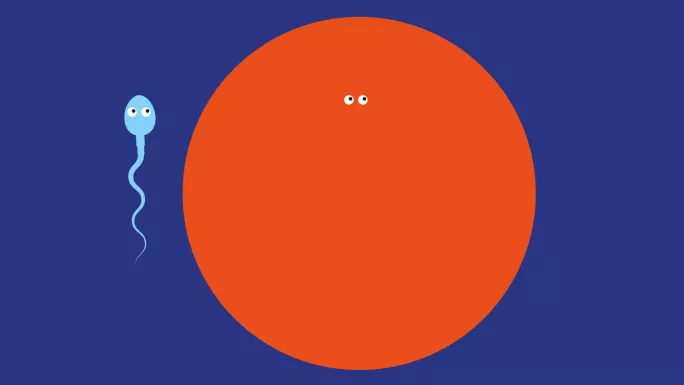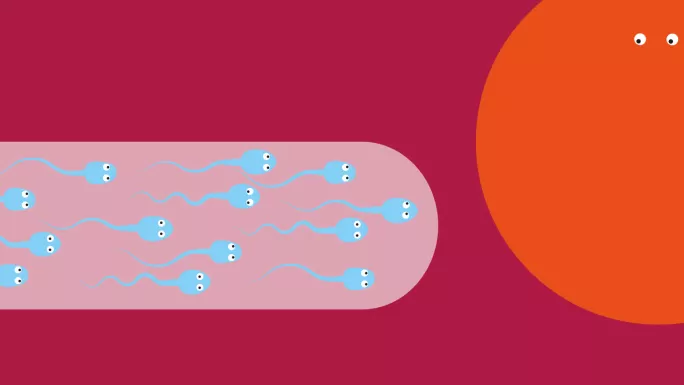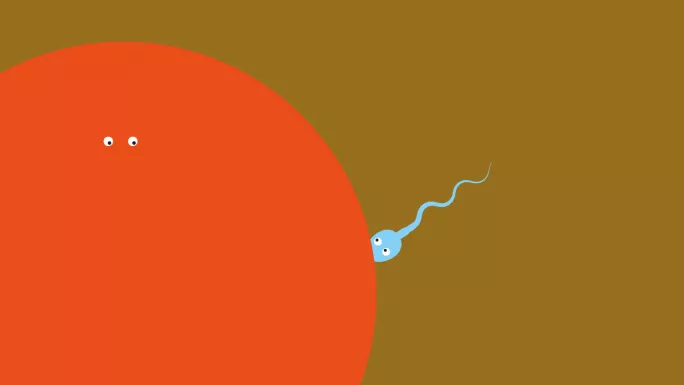- Home
- The facts of life for the YouTube generation
The facts of life for the YouTube generation

“Vaginas, vaginas, vaginas. Well, actually, this video isn’t about vaginas. It’s about vulvas. Vulvas, vulvas, vulvas.”
The woman who is speaking to the camera is standing in what looks like a typical millennial’s bedroom, complete with fairy lights and a festival-ready flower crown. Her name is Hannah Witton and she is one of a number of vloggers producing modern, straight-talking sex education videos.
These videos are shared on YouTube channels and they’re proving seriously popular. UK-based Witton has more than 280,000 subscribers. The channel “Sexplanations”, headed up by US-based clinical sexologist Dr Lindsey Doe, has over 270,000, while US-based Laci Green, who’s been dubbed “the sex-ed queen of YouTube”, has nearly 1.5 million. In terms of view counts for their individual videos, all three regularly notch up millions.
Their influence isn’t going unnoticed. Witton, for example, has produced content in conjunction with the likes of NHS Go (an app for young people) and Childline. And articles on popular teen platforms are celebrating sex-ed vlogs as a valuable resource: one piece on sugarscape.com (a UK-based online magazine for teenage girls), for example, discussed “The best YouTubers out there talking all things sex ed”, while an article on mtv.co.uk rated “Seven vloggers giving out awesome sex advice”.
All this suggests the approach of these vloggers may be how young people now want their sex education - bold, broad in topic and, preferably, bang on the latest trends.
Which raises an interesting question: how many Laci Green videos have those in the Department for Education tuned into?
For in December, it was revealed that the DfE is putting together plans to make sex and relationship education (SRE) compulsory in all schools. The SRE currently offered in classrooms (beyond compulsory modules in secondary science, many schools deliver it more extensively and to other age groups as part of PSHE) has been criticised by both official bodies like Ofsted and teenagers themselves.
In theory, if compulsory SRE is to fare better, anyone who is put in charge of forming the secondary level curriculum, providing resources or advising on pedagogy should try and tap into what does seem to be working where sex ed and teens are concerned: right now, that would appear to include what the vloggers are doing.
This may sound controversial, and to some - who believe that these videos deal with inappropriate topics and are dangerous distractions from “proper” SRE - it is. Yet if compulsory SRE is to have an impact, delivering the content teens want in a manner that engages them will be an important part of the teaching mix. To do that, teachers may well have to spend some time with Dr Doe and friends.
Statutory SRE?
The proposal to make SRE compulsory in schools is not without its critics: while education secretary Justine Greening’s apparent intention to use the soon-to-be-finalised Children and Social Work Bill to make it happen was greeted with widespread praise, dissenting voices were raised, too.
Many who responded to TES’ reporting on the story argued that a mix of parents and external sources is a better way of ensuring that teens get the right information, at the right stage of their development - rather than a “best-fit” curriculum delivered at an arbitrary age in a whole-class environment. How can you pitch the content correctly to a class at different levels of maturity and understanding? How can you avoid imposing information on those who might not be “ready”?
There were also concerns that teachers would be held responsible for yet another difficult-to-define job: what do successful outcomes look like? How do you avoid ideological leaning in what we teach as “normal” or “right” ways to behave? How do you even begin to fit everything in?
While pro-compulsory SRE groups admit that these issues need to be ironed out, they don’t believe they are barriers to warrant Greening changing her mind. Organisations such as the Sex Education Forum and the PSHE Association believe the case for statutory SRE is unarguable - and that it would answer some of the above queries.

“We’ve got such a huge range in quality at the moment, from really excellent practice in some schools to others doing very little,” explains Dr Polly Haste, from the Sex Education Forum.
“One key barrier is that it’s not a statutory requirement and therefore it’s not a priority for the majority of schools.
“If SRE were statutory, you would have a well thought-out, comprehensive curriculum and a structure for assessing students’ learning. You would also need proper training programmes for specialist teachers. That would create a whole different situation in schools where people had chosen to teach the subject and there was a framework for them to deliver it.
“All the data says that school is young people’s preferred source of information about sex. They have a legal entitlement under the international rights of the child to accurate, factual information about their bodies, health and how to stay safe. We cannot leave them to their own devices, as we would not be meeting statutory obligations to safeguard children.”
Advocates do admit, then, that current SRE teaching is not always as good as it could be, and that if SRE was to become compulsory this would need to be tackled. The rise of the sex-ed vloggers, some argue, could even be a reaction to poor SRE in schools.
“We are not sure how many young people are watching sex and relationships vlogs,” says Jenny Barksfield, PSHE Association senior subject specialist and deputy CEO.
“However, we know they are increasingly turning to the internet for information on all aspects of life, so it’s not surprising this would include vlogs on sex and relationships - especially if they feel that the SRE they receive in schools does not meet their needs. Where pupils are getting high-quality PSHE education, including SRE, we would expect the need to find answers online would be greatly reduced.”
How much of SRE provision that occurs in schools is “high quality”? Well, a 2013 report by Ofsted concluded that SRE required improvement in more than a third of schools. One concern was that, in secondaries, “too much emphasis was placed on ‘the mechanics’ of reproduction” with not enough focus on issues including sexuality, pornography and healthy sexual relationships.
Teenagers are voicing their own concerns in comments below the sex-ed vlogger videos. Witton says that viewers frequently cite a lack of quality SRE at school.
“People will often comment on my videos or tweet me about how their school sex education is lacking,” she says. “I would rate the sex ed I received in school as ‘basic’. I got the information to prevent me from getting STIs or unwanted pregnancies but there was nothing about consent, LGBTQ+, porn, body image or pleasure.”
It’s clear that, if we are to make SRE compulsory in schools, we may need a new approach. And teenagers are indicating with their viewing habits that this approach should perhaps be influenced by the sex-ed vlogging community.
‘Confident’ sex educators
That these SRE vlogs are popular with teens is undeniable. YouTube can only give accurate data on those viewers who log in or subscribe to channels, but that data is compelling in itself.
In analytics that Witton’s team shared with TES, the data she has about the nearly 21.6 million total views worldwide in her channel’s lifetime (five-plus years) suggests that 15 per cent have been from 13- to 17-year-olds and 50 per cent from 18- to 24-year-olds. Roughly 60 per cent of her audience is in the UK.
Data that Doe shared with TES about her YouTube channel shows similar trends. Of the nearly 6.6 million minutes of watch time of “Sexplanations” in its lifetime (three-plus years) by the UK audience specifically, 12 per cent involved 13- to 17-year-olds and 50 per cent 18- to 24-year-olds. (YouTube does not collect data on under-13s, who are not allowed accounts).
The teenage audience is secondary to the young adult audience, then, but that does not mean that more teens than the already significant number cited are not watching - many could be doing so without logging in.
“It comes up regularly through teachers - mostly through those who have engaged with their students and asked them where they are going for sex education outside of school,” says Haste.
The prevalence of 18to 24-year olds logging on may also be an indicator of sex-ed issues at school: this is the age bracket when many young people are more likely to be having more diverse sexual experiences and, suddenly finding their previous education insufficient on everything from STIs to porn and consent, they may be turning to the internet for help.
In the two age brackets, both boys and girls are watching - Witton’s audience, for example, is 40 per cent male and 60 per cent female.

So, what is it that young people find so engaging in these vlogs? It’s clearly more than simply a dearth of information elsewhere. According to Dr Pandora Pound, a research fellow at the University of Bristol, young people want sex educators that are “confident, unembarrassed, straightforward, approachable, unshockable and experienced at talking about sex”.
Dr Pound headed up a recent review of international studies into young people’s views of school SRE. “They want [teachers] to use everyday language, to have experiential knowledge of sex, to be comfortable with their own sexuality, to be good at working with young people and to be able to relate to and accept young people’s sexual activity,” she says. “Young people also want sex educators to be enthusiastic about teaching the topic. Vloggers such as Laci Green possess all these qualities and more.”
Haste adds that in terms of content, the vloggers are covering the topics students want to learn about, rather than just the topics adults think they should learn about.
“I think we do know that lots of these platforms are addressing issues young people say over and over they want to talk about in the classroom,” she explains.
Hot topics
The topic choice of these sex-ed vlogs is certainly diverse. Witton’s most popular videos include “Do I Look Like a Slut?”, “Sex Toys”, “Masturbation”, “Lesbian Stereotypes with Arielle!”, “I Got Dumped” and “Sexual Fantasies”. Meanwhile, you can find Green discussing “Freaky Labia”, “Losing Your Virginity” and “The Truth About Pulling Out”.
A lot of the content and aspects of the vloggers’ approach are clearly far removed from most current SRE practice - and some way out of a lot of teachers’ comfort zones.
In terms of the style of teaching, some of the attributes that Pound lists would not represent too much of a change for schools. Most teachers will - hopefully - already be using everyday language and be good at working with young people. But there are some issues that need to be considered.
For example, relating to and accepting students’ sexual activity is problematic when the legal age of consent is 16 years old.
Haste says that teachers may struggle to talk as openly - and with as much confidence - as the YouTubers, too.
“I think that we all struggle to talk openly and frankly about our bodies and sex in our daily lives as adults, and this is more pronounced in front of a classroom of young people. We don’t get the chance to practise using the correct language and, culturally, it’s still not normalised, so it can feel very awkward,” says Haste.
Training, she argues, could solve these problems, though. “If teachers are trained and want to teach SRE, that removes that awkwardness,” she says.

Embracing some of the topic choices of the vloggers would be more difficult. While no one is saying schools should just transfer the “most popular” list on the most popular sex-ed vlogger channels into schemes of work, certainly there is a need for the most popular topics among teens to be understood by teachers of SRE so they can judge whether those topics should be addressed in class. Vlogs are one way of finding out what those topics are.
And Haste adds that, in some circumstances, the videos could be played in a lesson as a conversation starter, where the teacher feels the vlogger is better at introducing the topic.
“Vlogging is a great teaching resource because it’s very direct and helps to break down that barrier of formality. I use Hannah Witton’s vlog about why you should look at your vagina as one example. [Haste suggests it might be appropriate for Year 9 upwards, at the teacher’s discretion]. Teachers are always clear they would struggle to explain this in the frank way Hannah does, and it’s a useful starting point for young people to explore the different use of terms, myths around the body and to focus on positive attitudes towards the body and genitalia.”
It is almost certain that any attempt to teach some of the topics listed above - even in watered-down form - would meet with criticism from a number of different angles, including from some among the teaching profession.
Playing the videos would be viewed by some as a career-ending move. And critics could easily point out that viewing figures should not be a justification: while the videos are certainly popular, hard figures on exactly how many teens are watching, beyond the data listed above, are hard to come by - many say that it is impossible to know.
It’s important to note, though, that no one is advocating that teachers use these vlogs indiscriminately or as a replacement for a teacher. Rather, they are saying we should not ignore vlogs just because the content and delivery may appear shocking, and that actually they could be useful as part of a wider mix of resources where the teacher feels they are appropriate.
“If [your students] have said ‘We’re all watching this, it’s great’, they’re telling you the format and medium that they are finding useful,” says Haste. “So it’s in your interests to engage with that.”
Some concerns would remain even then, though. “Clearly many vloggers are looking to address crucial issues for young people,” says Barksfield, “[but] we are concerned about vlogs being appropriate channels to deliver such potentially sensitive and complex topics, especially without there being some quality control. If the vlogger has received no training in how to teach such issues safely, they could inadvertently provide unhelpful - and in some cases even harmful - advice.”
‘Qualifications don’t matter’
In fairness, many teachers currently also lack training, but the difference is that schools’ SRE policies must adhere to government guidelines and strict safeguarding standards.
And yet, teens can access much worse than sex-ed vlogs on the internet - and the aforementioned videos are restricted by YouTube’s own rules on appropriate content and can be reported as inappropriate by members of the public. It’s also important to understand that vloggers such as Witton aren’t claiming any expertise that they don’t have or that they offer a comprehensive SRE curriculum for young people.
“I don’t think qualifications matter as long as you are transparent. I’ve never pretended to be a doctor or an expert,” says Witton. “I’m someone who has a passion for this field...Sex and relationships is something that we all experience and so it should be accessible for everyone to speak on it.”
That access to open conversations about sex and relationships is, of course, one of the main things compulsory SRE should aim to achieve. Teachers do not necessarily need to mimic the vloggers to achieve that, but the vlogs do provide an insight into what teens may wish to discuss - and how they want a teacher to deliver it - so that those conversations can happen. To ignore vlogs as a resource would be to ignore a chance to make SRE as successful as it can be.
“Many young people vlog about their experiences, and as a teacher this may be the only way to access resources about young people’s experiences of being trans, gender questioning, gay, a young parent or going to an STI clinic, for example,” says Haste.
“I don’t think any young people would say, ‘I’ve got enough sex ed on the internet, I don’t need anything from school’. We know that isn’t what they say. It’s almost like the more they access through the internet, the more they want to discuss what they find [when they are back] in the classroom.”
So the message to those who come to form the new SRE curriculum (should it happen) and those teachers delivering it is: don’t ignore the vlogs, but don’t let them define what you do either. Teachers should simply see them as a resource, not a threat or a catch-all solution.
As Dr Doe, she of the vlogs entitled “50 Ways to Hold a Vibrator” and “Vagina Mysteries Solved”, says: there is no substitute for a well-trained teacher. “Sex-ed vlogs are an amazing resource,” she says, “but they cannot replace the experience of learning with a room full of people and an expert devoted to organised and thought-out lessons.”
Jessica Powell is a freelance writer. She tweets @JPJourno
Keep reading for just £1 per month
You've reached your limit of free articles this month. Subscribe for £1 per month for three months and get:
- Unlimited access to all Tes magazine content
- Exclusive subscriber-only stories
- Award-winning email newsletters



